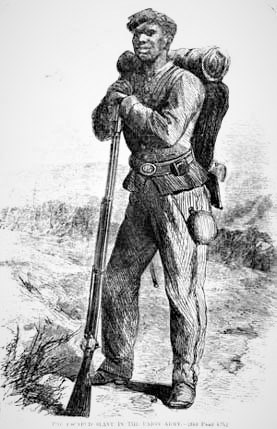Last updated: December 23, 2021
Article
Formerly enslaved man from South Carolina buried at St. Paul’s Served with Union army in Civil War

National Park Service
Formerly enslaved man buried at St. Paul's served with the Union Army in the Civil War
James Sinclair Polite, who is buried in the historic cemetery at St. Paul’s Church National Historic Site, served with the Union army in the closing stages of the Civil War in South Carolina, where he was born into slavery in the 1840s.As a 20-year-old, Polite enrolled in Company K, 35th United States Colored Troops in the spring of 1865, by which time most of the Confederate armies had surrendered to Union forces. The CTs, as they are called, were all-black regiments established in the middle of the Civil War as a means of utilizing African Americans, with an obvious motive to fight the South, without confronting widespread opposition to integrated units among Northern white citizens. Although not technically a CT, the bravery and alacrity of the famed 54th Massachusetts infantry in the attack at Fort Wagner, Charleston harbor in July 1863 expanded public support for the black regiments.
The unit Polite joined was formed in the fall of 1863, originally called the First North Carolina Colored Volunteers, and re-designated the 35th U.S.C.T. in February 1864. Most recruits were freedmen from the coastal areas of Virginia and the Carolinas. White northern officers led the regiment, including the Colonel, James C. Beecher, a half brother of Harriet Ward Beecher, author of the landmark antislavery novel “Uncle Tom’s Cabin”. Along with the 54th Massachusetts, the 35th effectively guarded the Union line of retreat at the Battle of Olustee, Feb. 20, 1864, the largest engagement of the war in Florida.
Polite joined the regiment on May 7, 1865, and his enlistment documents a distant, if partial, mirror of the volunteer. Of normal height at 5’ 8”, Polite is recorded as having dark eyes, dark hair and a dark complexion, a common description for CT recruits. Residence and birthplace are listed as Charleston. He was employed as a “farmer,” which meant he had been enslaved before and probably during the Civil War, likely achieving his freedom as a result of the dislocation of the conflict and the Emancipation Proclamation. The enlistment form was filled in by a captain of the 35th who wrote all the information, including signing Polite’s name, where the new soldier made an X mark, indicating limited literacy. While recruitment records don’t capture motivation, a composite understanding of the men who joined these regiments is offered by a historian of the 35th: “The Civil War was the defining event for the men who fought. For some black men, the war shaped their lives for the better by giving them the opportunity to achieve a greater sense of self-worth and pride in their accomplishments. Many black men only knew plantation work, and joining the USCT provided some with the chance for advancement and skill development.”
Polite served a year in the blue uniform, with the 35th functioning as an army of occupation in the defeated state which was the birthplace of secession. Posted to Charleston through the summer of 1865, the regiment guarded the rail lines, vigilant against possible Southern guerilla activity. After garrisoning the city, the 35th was transferred to the countryside, facing occasional shots from disgruntled white state residents, and helping to administer activities of the Freedmen’s Bureau -- the Federal agency created to assist the former slaves’ transition to freedom -- particularly in the areas of land and labor disputes with former planters. From his record, it is clear Private Polite was a diligent soldier, marked present on all muster rolls, with no indication of illness or absenteeism. We can only imagine his feelings as a former slave standing guard near his former plantation. Honorably discharged on May 7, 1866, in conjunction with the disbanding of the 35th, the soldier received back pay of $24, or about $352 in today’s money.
Polite’s postwar journey followed a common migration pattern of freedmen from South Carolina along the rail lines to New York City, although he seems to have been the bold one in his family, seeking a better life in the North while his five siblings remained in the South. In 1872, he was living on Grand Street in lower Manhattan, employed as a waiter in Tenafly, N.J., a lengthy 19th-century commute facilitated by streetcars and a ferry across the Hudson River. His wife Anna R. was from Georgia. Possibly through the army, the former CT private had acquired the ability to write, signing an application for an account in the Freedman’s Bank, financial institutions created during Reconstruction to safeguard the funds of African Americans.
By the 1890s -- if not earlier -- the Union veteran, Anna and their son, also named James Polite, had moved to Mt. Vernon, about 20 miles north of Manhattan, corresponding with the growth of the suburban city’s African American population The family lived on Mt. Vernon Avenue, with James employed as a clerk, probably at one of the stores in that western section of the city. The soldier of the 35th died on Nov. 19, 1903, at age 58; interment followed in the City section of the St. Paul’s cemetery. Pride in his service lingered, since the grave is marked with a marble veterans’ gravestone.
